Texas Style Smoked Pulled Pork
(
REVIEWS)
PREP:
30 minutes
TOTAL:
9 hours
SERVES:
10
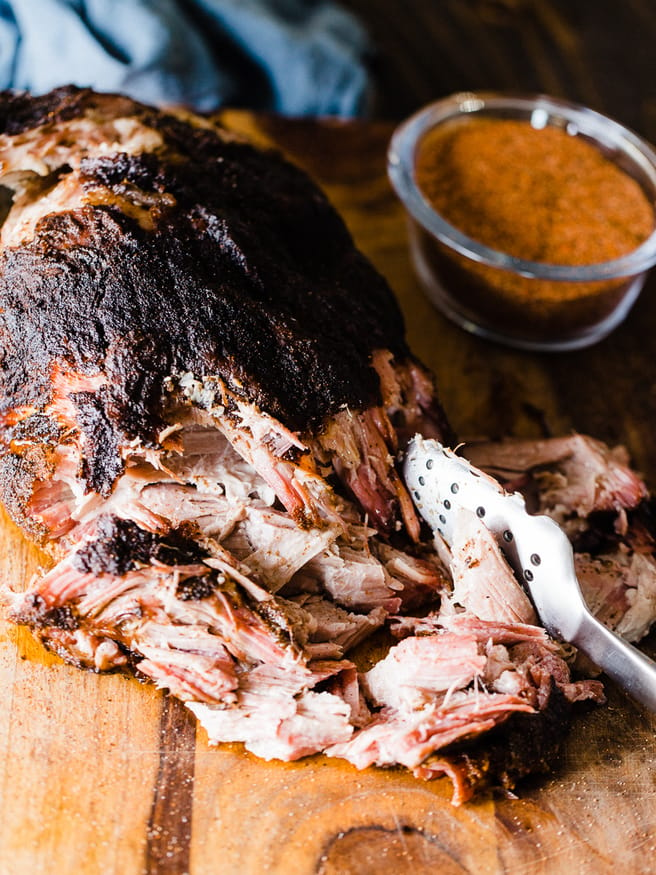
Texas smoked pulled pork. That’s not something you think of when you think of Texas right?
I’m smoking a pork shoulder low and slow, with a pepper based Texas style rub over hickory and applewood wood.
Normally when you think of smoked pulled pork you think of a typical sweet with some heat. A North Carolina style pulled pork.
In this post I’ll show you how to smoke pork shoulder or Boston butt over a blend of hickory and apple wood and then coated with a central Texas pepper-based rub.
We will explore the history of central Texas style barbecue, the difference between pork shoulder and Boston butt, the equipment needed to smoke pulled pork, the best wood to use, the ingredients needed for the rub, how to smoke pulled pork, troubleshooting, tips, and tricks to make the best-smoked pulled pork.
What makes a smoked pulled pork “Texas style”
After doing some research on how to smoke my pork shoulder (or Boston butt), I read through Aaron Franklin’s Meat Smoking Manifesto.
I highly recommend picking up this book if you’re into making your own barbecue. I found that he seasons pulled pork a little different.
And his flavor profile stems from Central Texas BBQ.
History of Central Texas Style Barbecue
Let’s get nerdy for a minute…
Central Texas style barbecue has a long history that can be traced back to the late 1800s. German and Czech immigrants who settled in the area brought with them their traditional methods of smoking meats.
They used a simple dry rub made of salt and pepper to season the meat and cooked it low and slow over hardwood smoke.
This cooking method allowed the meat to develop a flavorful bark on the outside while staying tender and juicy on the inside.
Over time, central Texas barbecue has evolved, and various restaurants and pitmasters have put their unique spin on the traditional method.
The use of different types of wood, rubs, and sauces has resulted in a wide range of flavors and textures.
Despite the variations, the core principles of central Texas barbecue remain the same – low and slow cooking over hardwood smoke and a focus on quality ingredients and simple, yet flavorful rubs.
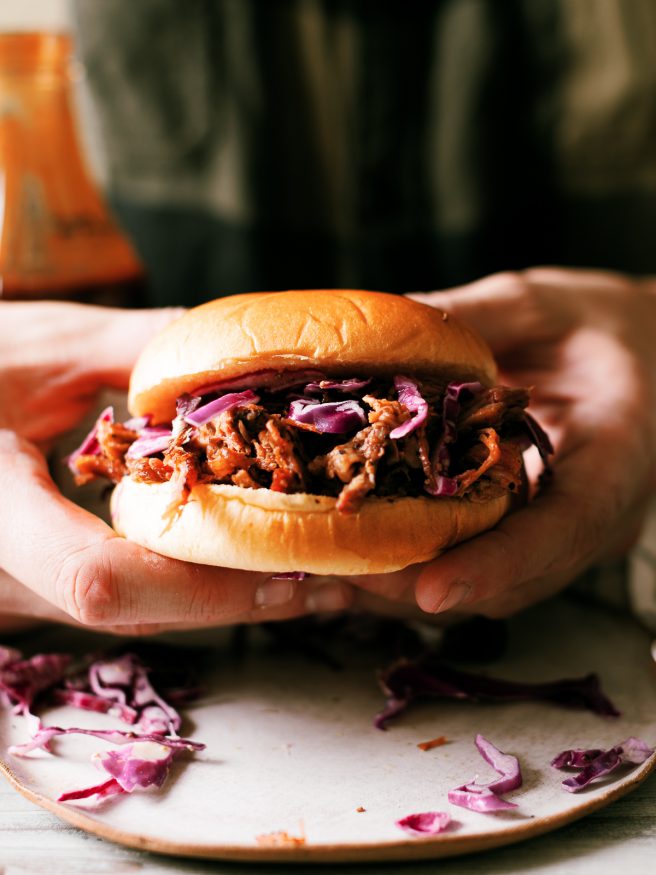
What Central Texas Rub?
A central Texas style rub starts with 1 part salt, 1 part pepper. I decided to take some inspiration from the man who has barbecue nailed down and take my own take on it!
If you want a true pulled pork Texas-style, leave it at that. I added a little bit extra spices like cayenne, paprika, and a hint of sugar jut to make it my -own.
Want to know the best part? You can grab my exact rub over on my shop, just look for the red Savory Pork Booty BBQ Rub label!
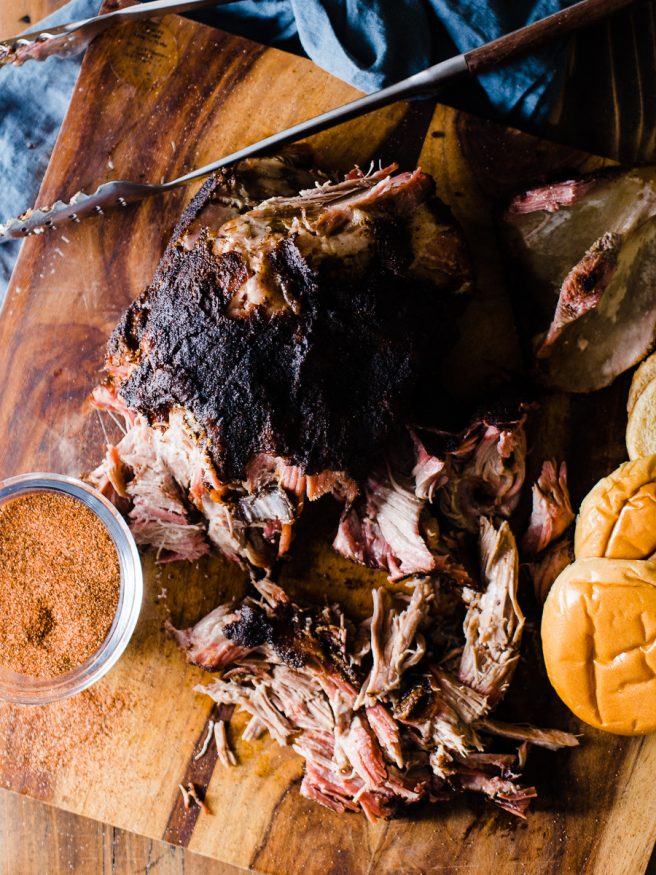
Pork Shoulder vs. Boston Butt
When it comes to smoking pulled pork, there are two cuts of meat that are commonly used – pork shoulder and Boston butt.
But don’t get overwhelmed.
Although these cuts come from different parts of the pig, they are often used interchangeably in recipes.
The pork shoulder is the top part of the front leg of the pig, while the Boston butt comes from the upper part of the shoulder.
While both cuts of meat are great for smoking, they have slightly different characteristics.
The pork shoulder has more fat marbling, which makes it more forgiving when it comes to cooking. It also has a slightly more pronounced pork flavor.
The Boston butt, on the other hand, is slightly leaner and has a milder flavor. It is also easier to carve and has a more uniform shape.
I’ve used both and in my experience, they’re both really hard to mess up for a pulled pork recipe.
My advice? Go with what fits in your budget or is readily available.
What Equipment to Use to Smoke Pulled Pork
To smoke pulled pork, you will need some equipment. The most important piece of equipment is a smoker.
There are several types of smokers available, including charcoal, electric, pellet, and wood-fired smokers. Each type has its pros and cons, and it really comes down to personal preference.
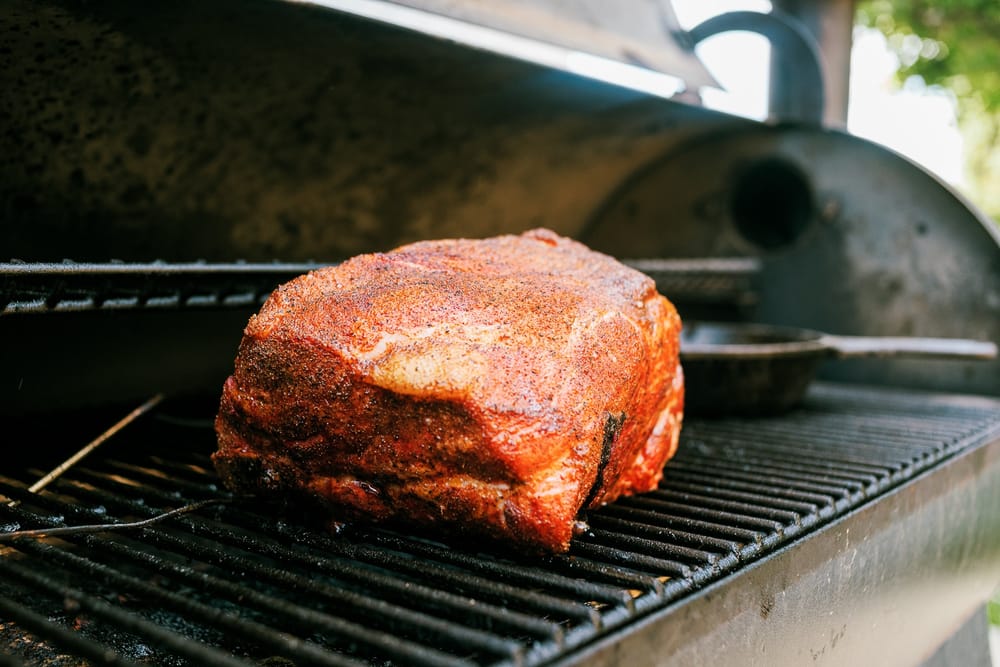
Pellet Smoker
If you are new to smoking, a pellet or electric smoker might be the best choice. They are easy to use and require minimal attention during the cooking process.
Don’t let anyone talk you down – this “easy bake oven” of backyard barbecue will deliver consistent result and is relatively hands off.
The pellets are fed into a hopper that automatically delivers them to the firepot, which ignites and burns the pellets.
And the grill has a thermostat that regulates the temperature, making it easy to set the temperature and walk away.
Pellet grills are versatile and can be used for smoking, grilling, roasting, and baking. They also produce less smoke than traditional smokers, which some people prefer.
If you’re looking at a Pellet grill a few models to check out are the Traeger Grills Pro 34 Electric Wood Pellet Grill , Rec-Tec, and if you’re feeling spendy, Yoders Smoker has an awesome model as well.
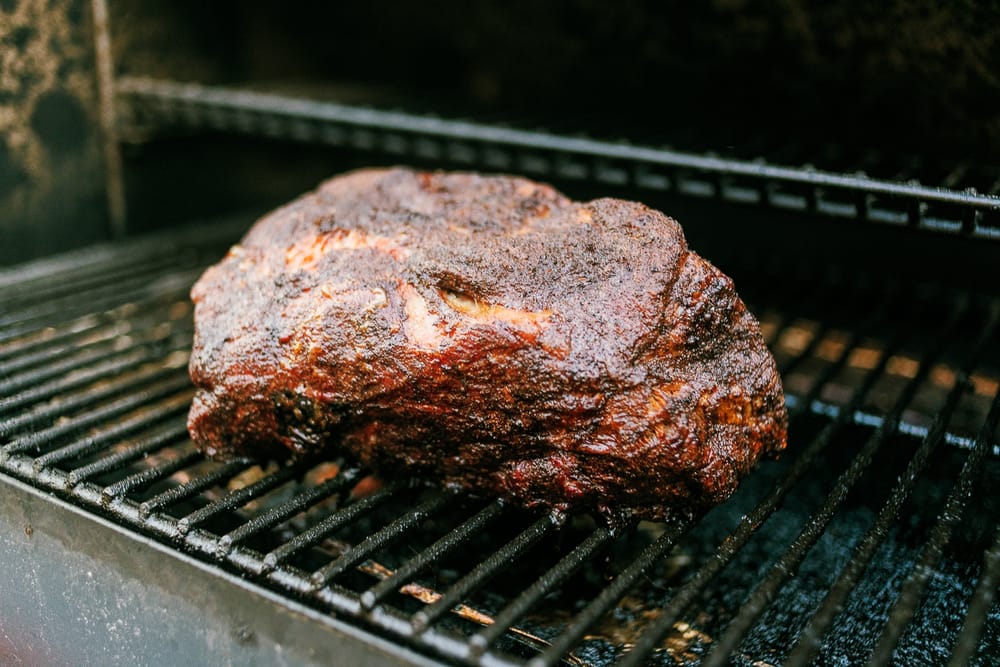
Traditional Smoker
If you are looking for a more traditional smoking experience, wood-fired smoker might be a better choice.
They require more attention and skill, but they also offer a more authentic smoking experience.
Also known as offset smokers, a traditional smoker uses wood or charcoal as fuel to produce smoke and heat.
An offset smoker has two chambers: a firebox and a smoking chamber. The firebox is where the fuel is burned, and the smoke and heat travel to the smoking chamber, where the meat is placed.
Traditional smokers require more skill to use than pellet grills because you have to monitor the temperature and adjust the fuel and air intake to maintain the desired temperature.
They also require more time and attention, as you need to add fuel and wood chips periodically to maintain the smoke.
While the learning curve is high, the final product of your pulled pork will be second-to-none. The flavor profile from a well maintained wood-fire will give you an amazing authentic barbecue smoke flavor.
A good offset smoker will cost an arm and a leg. A Yoder Loaded Wichita is a great option.
One of the newest ones to hit the market is the Franklin BBQ Pit that has received a lot of high praise from the backyard barbecue community.

Water Smokers
Another fun way to smoke a pulled pork is by using a water smoker.
Water smokers, also known as a bullet smokers are similar to traditional smokers. Except they use water to regulate the temperature and create moist heat.
The water is placed in a bowl at the bottom of the smoker, and the heat source is placed above it.
As the water evaporates, it creates a moist environment that helps to keep the meat tender and juicy.
Water smokers are easier to use than traditional smokers since they require less attention, but they don’t produce as much smoke flavor as traditional smokers.
But that may not be an issue.
Harry Soo has said to use his Weber Smokey Mountain exclusively when doing competition barbecue and has one many awards on it.
Another great option is a a ceramic grill like a Kamado Joe
Ingredients Needed
To make the perfect Texas Style Smoked Pulled Pork, you’ll need the following ingredients:
- Pork shoulder or Boston butt: We’ve already gone over this, so lets talk about size. You’re looking at about 90 minutes per pound at 225° to 250°. For reference a 10 lb pork shoulder will give you about 6 pounds of pulled pork, feeding 12-18 people. So plan accordingly.
- kosher salt: The key to a good rub is the right balance of salt and pepper. It’s important to use kosher salt instead of table salt, as table salt is more fine and can easily over-salt the rub.
- ground black pepper: This is the second key ingredient in the rub. The coarse grind – 16 mesh to be exact – of the black pepper adds texture and flavor to the rub.
- paprika: While some argue that it will add a rich, smoky flavor, I’d argue that this is just for color adding a deep red color to the rub. A mild paprika will do just fine.
- granulated garlic: Granulated is the key word here. Granulated garlic has a coarser texture and stronger flavor, and will avoid caking. It also adds a savory note to the rub and complements the pork well.
- granulated onion: Similar to the granulated garlic, this adds another layer of savory flavor to the rub. It also helps to thicken the rub and prevent it from clumping/caking.
- cayenne pepper: This adds a bit of heat to the rub. If you don’t like spicy food, you can leave it out, but if you want a little kick, add it in!
How To Smoke Pulled Pork
Alright. Ingredients and equipment have been laid down. Now lets attach the preparation and cook.
Trim the fat
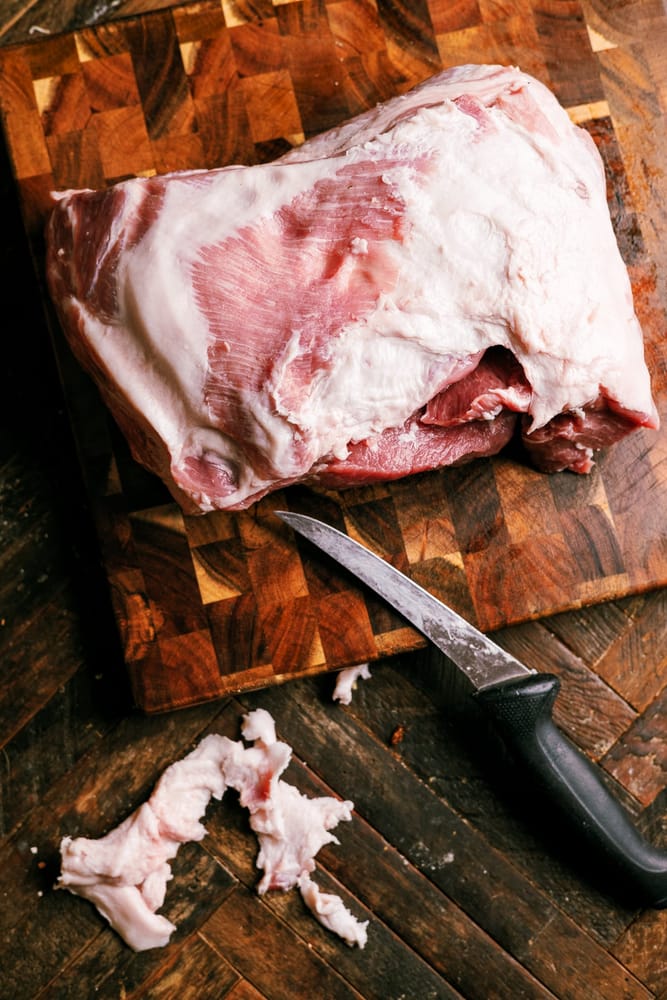
Pork shoulder and Boston butt already have a high fat content, so there’s no need to leave a layer of fat on.
Unless you’re worried about protecting your meat from a hot zone.
Trim as much fat as possible so that the meat takes on the smoke and rub flavor.
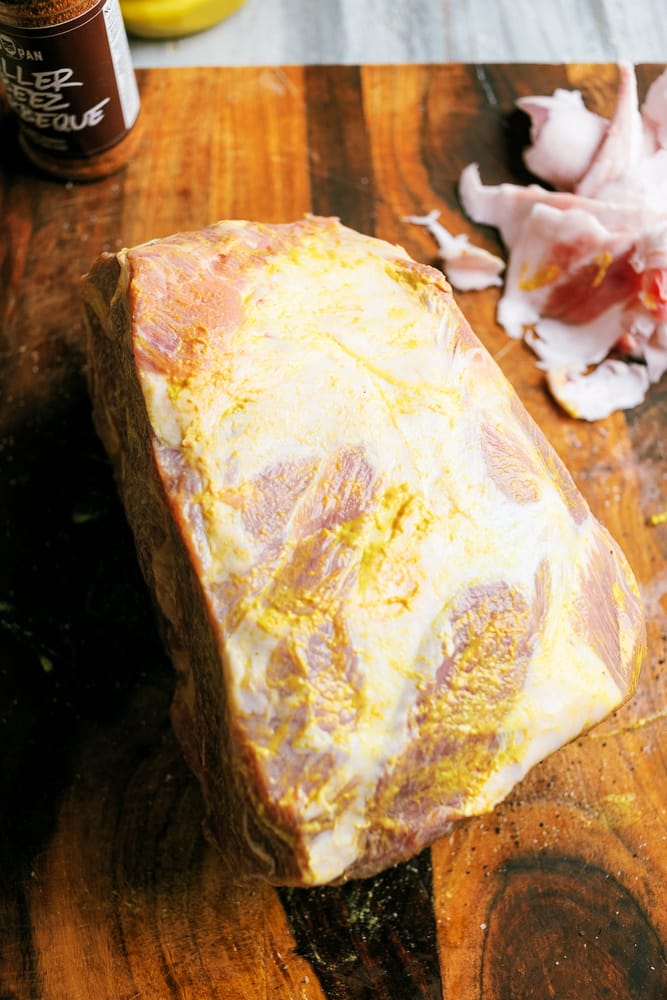
Bind and rub
As far as a binder goes, this is optional, but I recommend it.
Add a thin layer of mustard, oil, or apple cider vinegar and apply a liberal portion of your rub. Go easy on the binder; too much and you’ll risk ruining your bark.
Experiment with olive oil, mayo (I’ve seen Worcestershire too on briskets) to help get a good coating of rub to your smoked meat, and see what you like best.
One thing not to get too caught up what you’re using as a binder. Its not doing much for flavor as much as the rub itself.
It’s just a way to get your rub to stick to help develop a good bark.
Start the smoke
235°F is a sweet spot temperature. Everyone has a preference, from the standard 225°F all the way up to hot and fast 350°F.
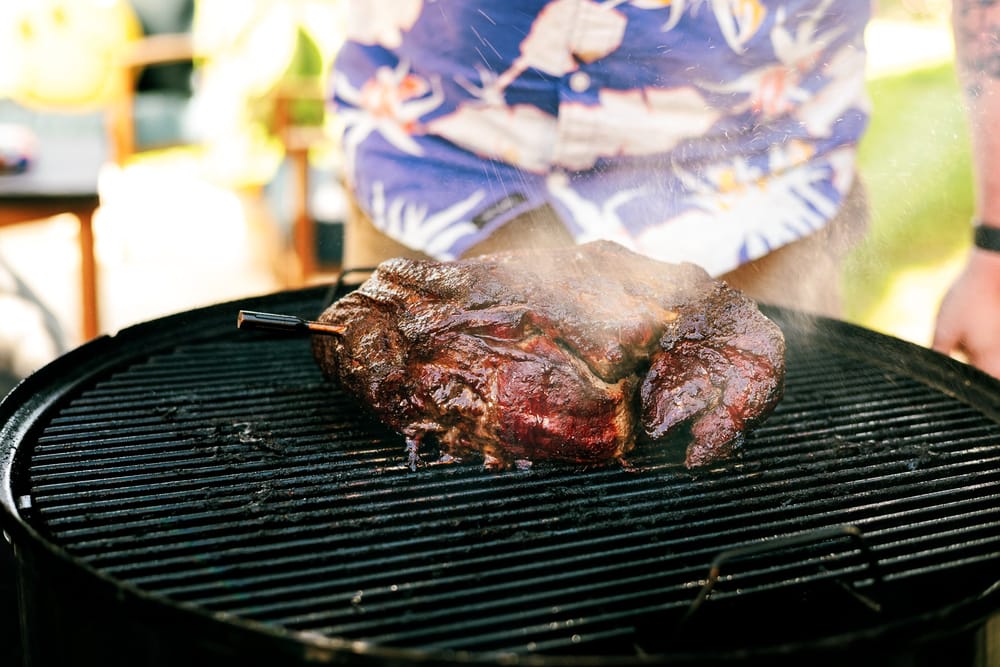
Spritz your meat
Let your pulled pork ride for the first 90 minutes without looking.
Then, every 45-60 minutes, spritz with liquid.
You can use water, a 50/50 water/apple cider vinegar mix, apple juice, or a combination of any in between.
Make sure your bark is set
Before heading to the next step lets talk about making sure the bark is set. A properly set bark will not rub off when you touch it.
Take your finger and lighting scrape the bark. if it starts to rub off, your bark has not set and your should continue to cook unwrapped.
If the bark does not rub off when you scrape, then your bark is set, and you can make your wrapping decision when you’re ready.
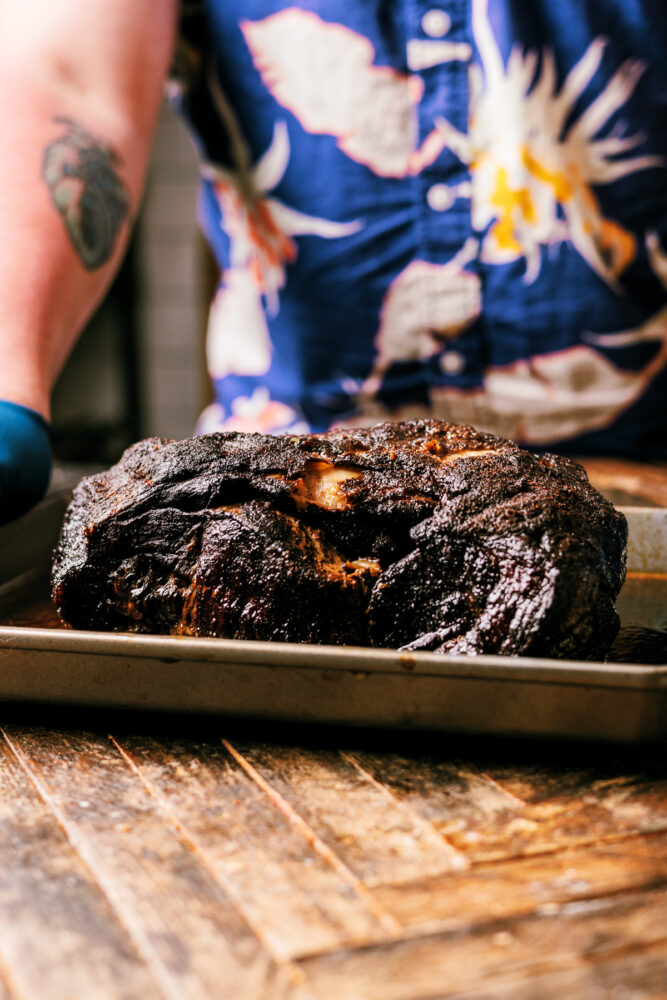
Wrap it up (or don’t)
Once it hits the stall around 160-165°F, it’s time to make a decision to wrap. If you decide to wrap, you can go with pink butcher paper, or aluminum foil.
Butcher paper will allow your pulled pork to breathe a little more than aluminum foil will, giving a better bark.
I’ve experienced a faster cook with aluminum foil. You can use it to get your cook time sped up if you’re running behind.
Another method I user placing a pan underneath the pork after wrapping. This will let any juices pool and will almost acts as a braising juice to incorporate back into your pulled pork to bring that flavor into the entirety of your meat.
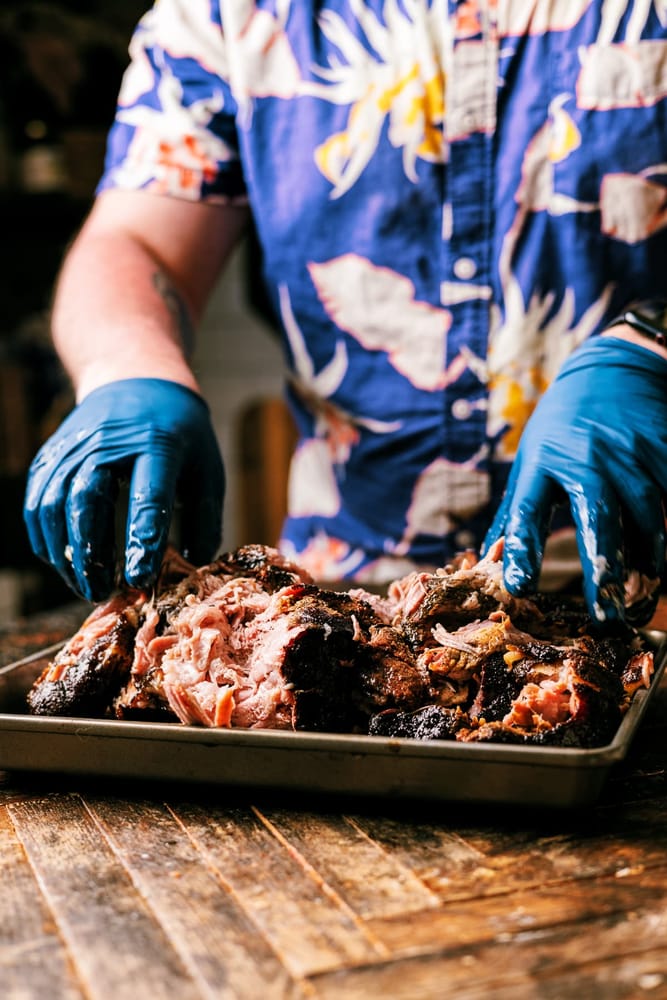
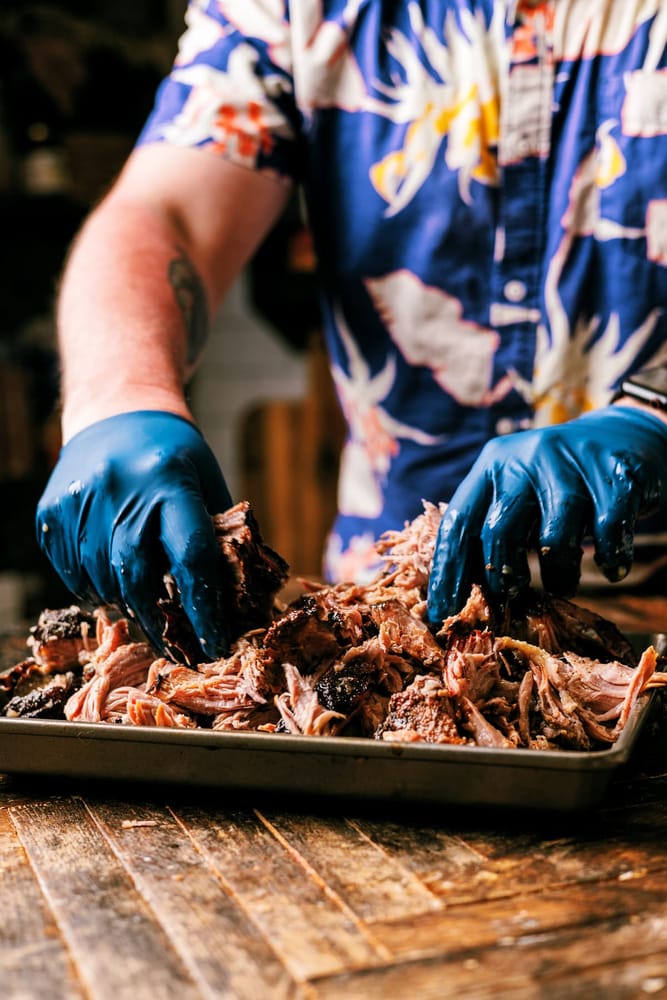
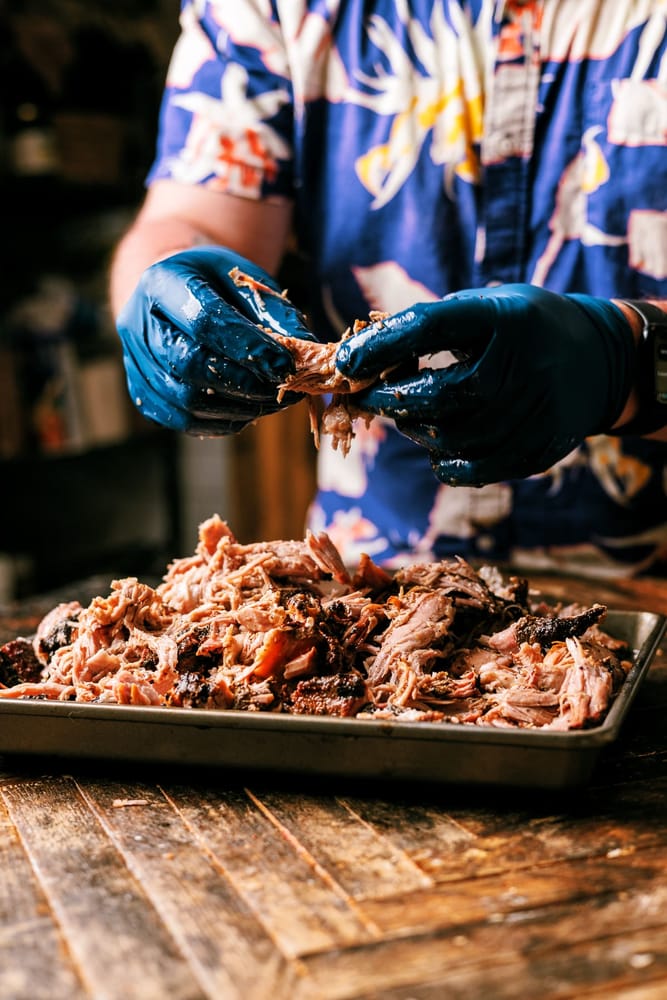
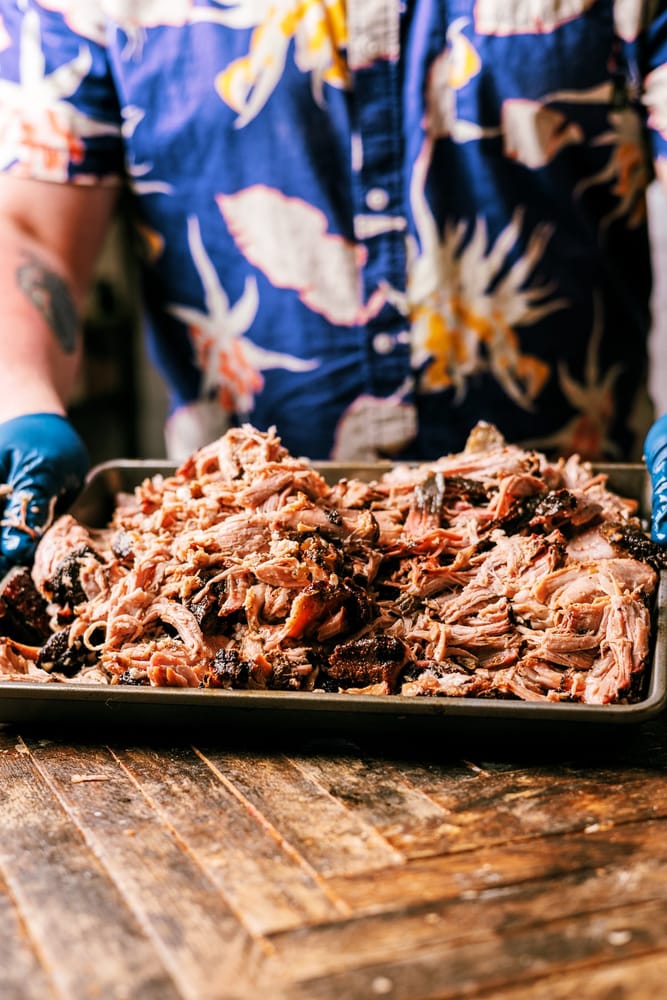
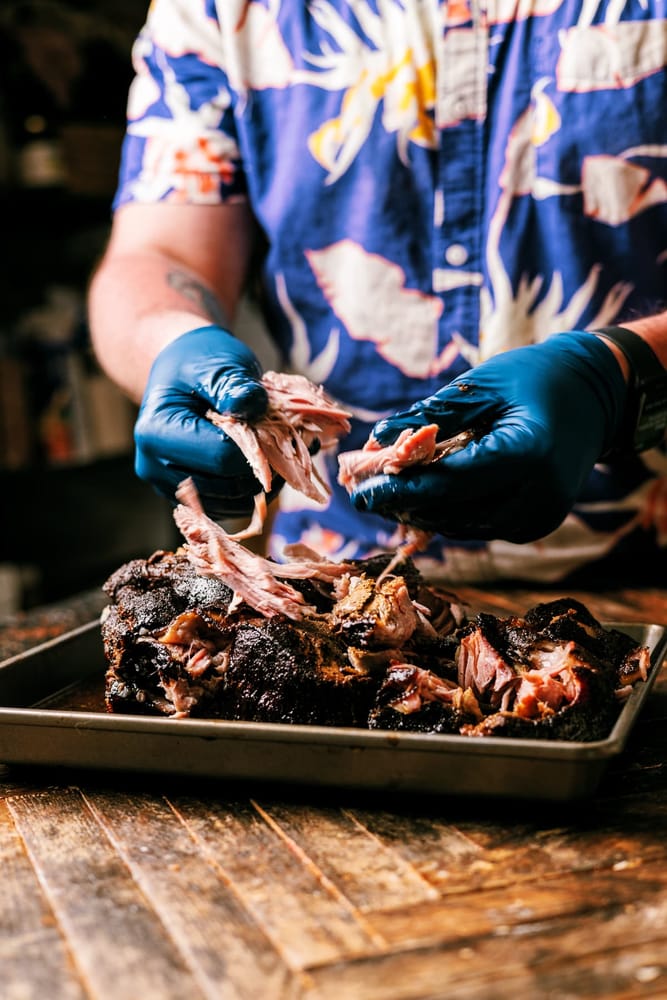
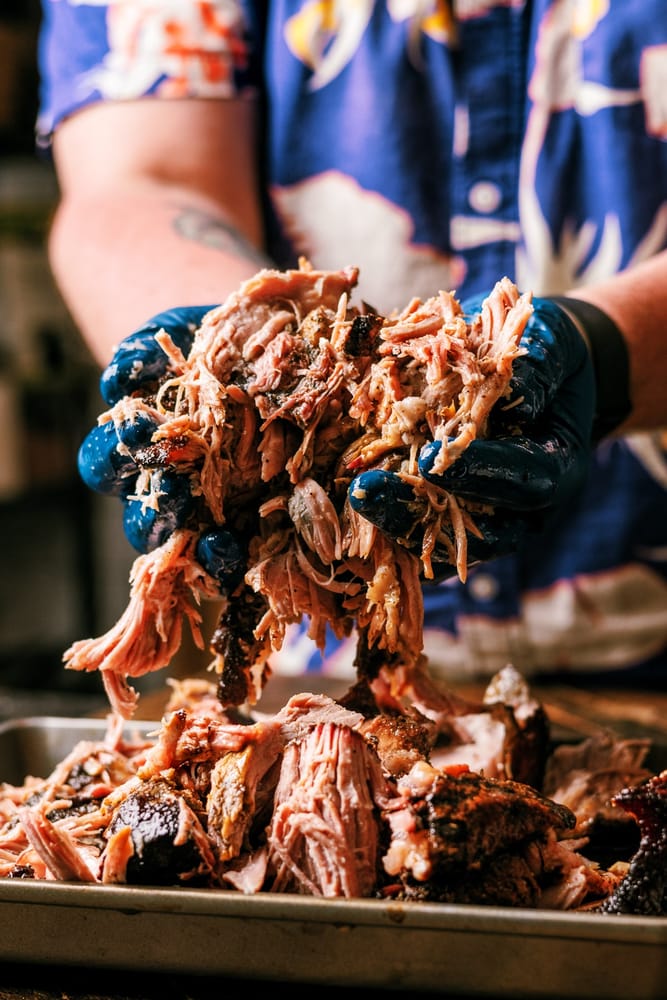
Pull, rest, and pull
Once it’s probe-tender, meaning you can puncture it with your probe and it feels like warm butter, it’s time to pull around 195-205°F.
Let it rest until it comes back down to around 165°F, then it’s ready to pull apart.
Season and eat
Add a bit more of the Texas-style rub, with 1 part BBQ sauce to 2 parts apple cider vinegar. This step is totally optional but so good!
How long to smoke?
The one thing you’ll need to focus on is timing. Smoking a pork shoulder takes about one and a half hours per pound of meat. Allow for at least 60 minutes of rest time.
I like to shoot for getting my pull pork done an hour before serving. And if it’s done early, you can always keep it wrapped in foil and placed in a cooler. It will hold its temperature for a few hours.
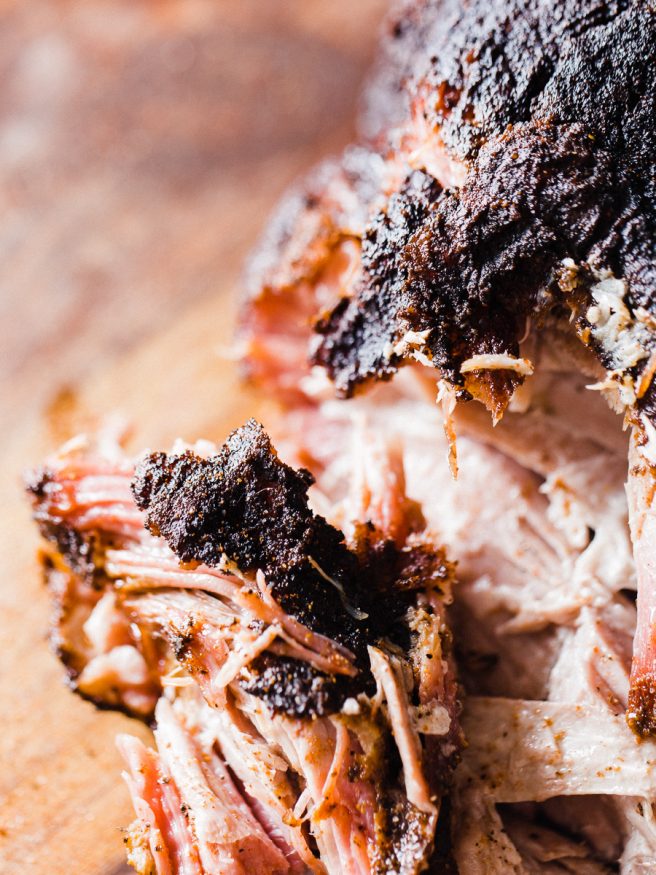
Troubleshooting your pulled pork
Something gone wrong? Here’s a few tips:
The bark is too hard
If your bark is too hard, it’s likely that the temperature was too high. Or.. you left it in the smoker for too long.
You can try lowering the temperature or wrapping the pork earlier
The pork is dry
This should not happen easily, due to the high fat content, BUT.. If your pork turns out dry, it’s likely that it was cooked for too long or at too high of a temperature.
Another reason for dry pork could be that it wasn’t spritzed often enough during the smoking process.
To prevent this, make sure to spritz your pork every 45-60 minutes and keep a close eye on the internal temperature. You can also try wrapping the pork earlier to keep the moisture in.
The pork is undercooked
If your pork is undercooked, it’s likely that it was not cooked for long enough or at a high enough temperature.
Check the internal temperature with a meat thermometer to make sure it reaches 195-205 degrees Fahrenheit. More important that temperature, pulled pork should also feel like butter when you probe it.
If you find that your pork is undercooked, you can always put it back in the smoker until it reaches the desired temperature.
This can also happen if you did not allow your pork butt to rest long enough. Try giving your pork enough time to relax, and come back down to about 165 F.
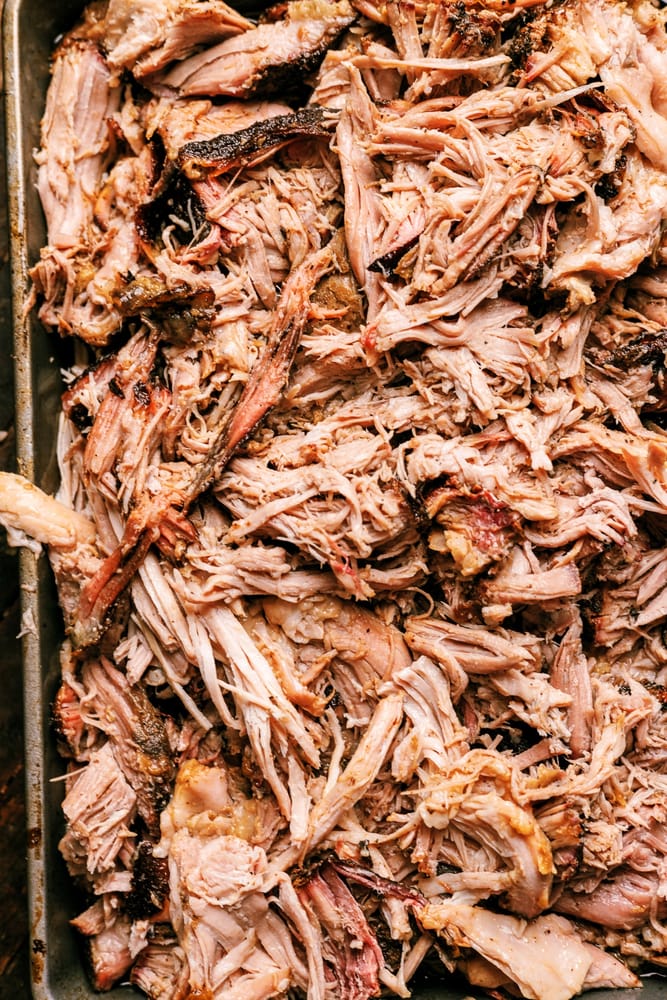
The pork is too smoky
Yes. a SMOKED pulled pork, can be too smoky.
If the pork has too strong of a smoky flavor, a couple things could be at fault. It either has been cooked for too long uncovered or with wrong type of wood.
Try wrapping your pulled pork earlier in the cook, but after the bark has set.
You can also try a different wood blend. Many people will have this complaint when using a wood like Mesquite, which can overpower meat after a longer cook.
If hickory is what you used, try blending with a milder wood. I like to do a 50/50 split with apple wood.
The pork is not flavorful
If the pork lacking flavor, is the only problem you’ve encountered, consider this a successful cook!
Next time try adding more rub to your pork shoulder or adding some apple juice to your spritz.
For now, simply add more of your rub seasoning to your pulled pork. Try a little BBQ sauce as well before serving.
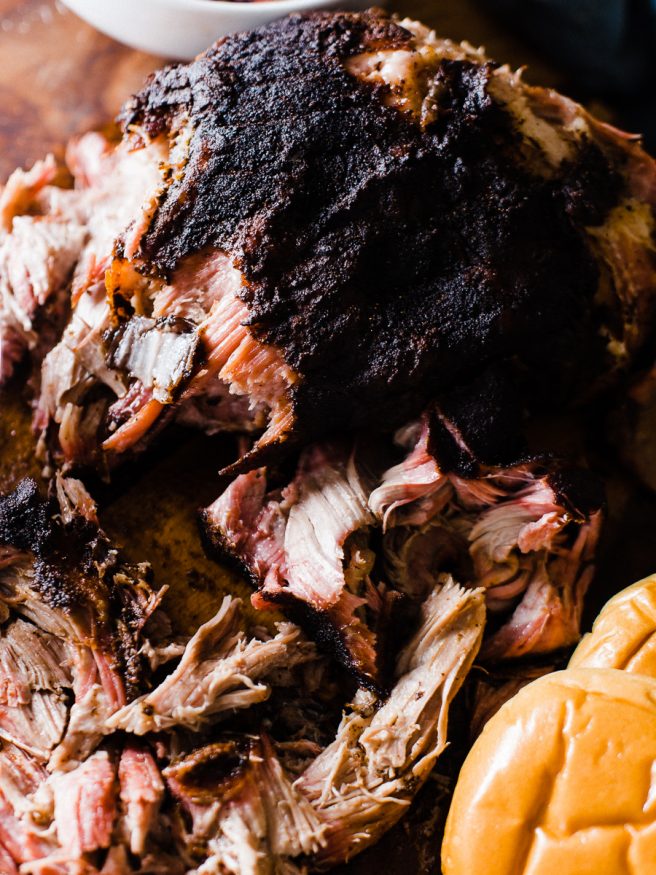
What wood to use
Choosing the right wood is an essential part of cooking the perfect smoked pulled pork. You want to choose a wood that will impart a smoky flavor without overwhelming the meat. Some popular options for smoking pork include:
- Hickory: This wood is strong and flavorful, and it pairs well with pork.
- Apple: Apple wood is a bit milder than hickory, and it gives the meat a sweet, fruity flavor.
- Cherry: Cherry wood is similar to apple wood in its flavor profile, but it has a slightly more pronounced smoky flavor.
- Oak: Oak is a versatile wood that works well with most meats, including pork.
My preferred blend is equal parts hickory and apple wood, then a chunk of pecan. Sometimes I’ll add cherry for a little color.
Smoked Pulled Pork: Tips and Tricks
Before you head off, let me leave a few more tips and tricks to your pulled pork barbecue arsenal.
Patience is key
Smoked pulled pork takes time and patience. It’s important to resist the temptation to check on your pork too often. This can let out valuable heat and smoke. Allow the pork to smoke undisturbed for at least the first 2 hours.
Invest in a good thermometer
A good meat thermometer is essential for smoking pulled pork. Make sure to test the internal temperature in multiple places. This will prevent any false readings, since there will be hotspots.
My go-to wireless thermometer for smoking is my Thermopro TempSpike Wireless Meat Thermometer
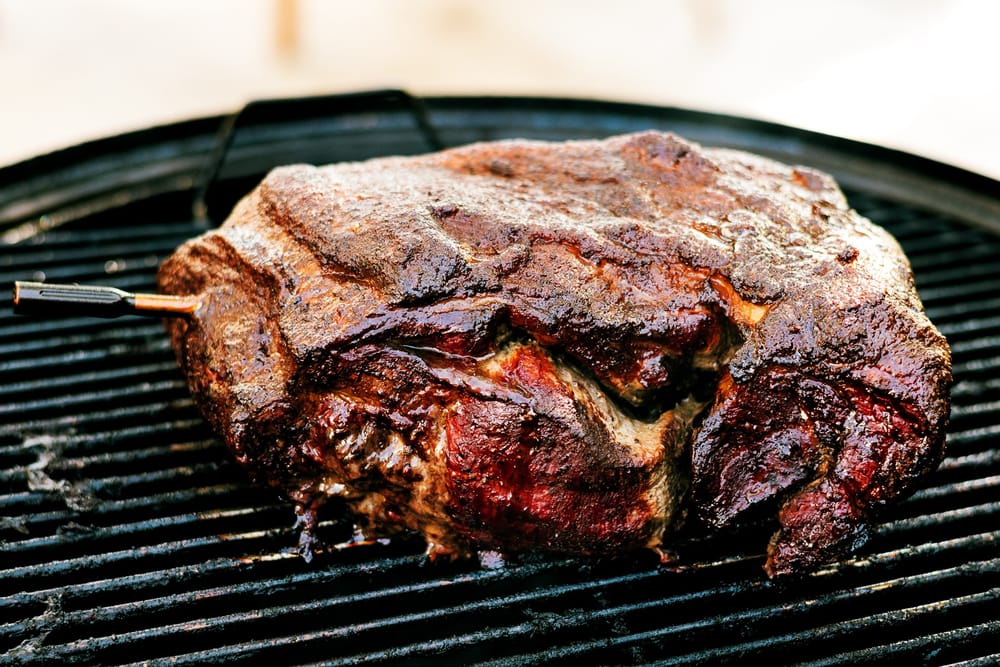
Keep the smoker closed
As mentioned before, opening the smoker too often can let out heat and smoke, which can affect the cooking time and temperature. Avoid opening the smoker unless you need to spritz your pork or check the internal temperature.
Let the pork rest
Let your pulled pork rest for 60 minutes before pulling it apart. This is important as it allows the juices to redistribute and results in a more flavorful and tender pork.
Use a spritzer
Use a spritzer bottle filled with a liquid of your choice to keep the pork moist during the smoking process. I recommend apple juice or a mixture of apple cider vinegar and water.
Spritz the pork every 45-60 minutes.
Experiment with different woods
While hickory and apple wood are classic choices for smoking pork, don’t be afraid to try other woods to see how they affect the flavor. Cherry wood, maple wood, and oak can all add unique flavors to your pork.
Don’t be afraid to wrap
Wrapping your pork in foil or butcher paper can help keep the moisture in and create a more tender pork. Experiment with wrapping at different times during the cooking process to see what works best for you.
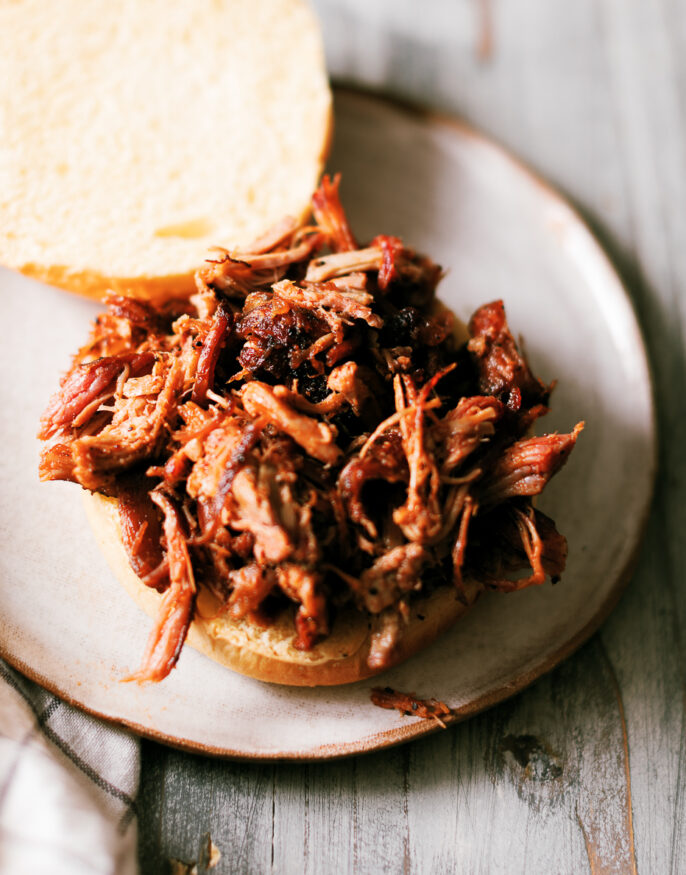
Leftover pulled pork ideas
The best part about smoking pulled pork, is the amount of leftovers you’ll have. You can freeze up to 6-12 months and reheat it for additional pulled pork sandwiches.
Or try the following recipes:
- Pulled Pork Taquitos – Simply heat up the pulled pork and serve it on a tortilla with some avocado, cilantro, and lime.
- Pulled Pork Nachos – Layer tortilla chips, cheese, and pulled pork on a baking sheet and bake until the cheese is melted. Top with jalapeños, sour cream, and guacamole. [SEE VIDEO]
- Pulled Pork Enchiladas – Combine the pulled pork with cheese and roll up in tortillas. Top with enchilada sauce and bake until the cheese is melted.
- Smoked Pulled Pork Quesadillas – Layer pulled pork, cheese, and your favorite veggies on a tortilla and cook on a griddle until the cheese is melted.
- Pulled Pork Cheese Fries – Heat of some french fries, top with cheese pulled pork, and some bbq sauce.
- Pulled Pork Fried Rice – Combine the pulled pork with rice, veggies, and soy sauce in a wok and cook until the rice is crispy.
- Pulled Pork Pizza – Top a pizza crust with BBQ sauce, cheese, and pulled pork. Bake until the cheese is melted and bubbly.
- Pulled Pork Chili – Combine the pulled pork with beans, veggies, and chili powder in a pot and cook until the chili is thick and hearty.
Smoking pulled pork is a time-honored tradition in Texas. With the right equipment, wood, and ingredients, it’s easy to recreate at home.
Remember to take your time, use a good meat thermometer, and experiment with different woods and rubs to find the perfect flavor for your pulled pork.
Pulled Pork FAQ
The best cut for smoking pulled pork is the pork shoulder, also known as Boston butt. This cut has a good balance of fat and connective tissue, which renders down during the long smoking process to produce tender, flavorful meat.
Smoking pulled pork typically takes around 1.5 to 2 hours per pound at a temperature of 225-250°F. The total time can vary based on the size of the pork shoulder and the consistency of your smoker’s temperature.
Pulled pork should be cooked to an internal temperature of 195-205°F. This range ensures that the collagen in the meat has broken down, making the pork tender and easy to pull apart.
Store leftover pulled pork in airtight containers or heavy-duty freezer bags. It can be kept in the refrigerator for up to 4 days or frozen for up to 3 months. Using a Vacuum Sealer and store in a deep freezer and leftovers will last up to a year. Reheat slowly in the oven or on the stovetop with a little added moisture to prevent it from drying out.
Yes, you can smoke the pork shoulder ahead of time. If a small batch, you can shred and store in an airtight container the fridge after its rested.
If a larger batch, I like to keep in foil and pack tightly with towels in a cooler the night before. It will hold a safe temperature for 8-12 hours. In the morning store in an oven set to 140-170 Fahrenheit. When ready to serve pull at that time and serve
With a little patience and practice, you’ll be making the perfect smoked pulled pork in no time!

Texas Style Pulled Pork
Ingredients
TEXAS STYLE PORK RUB
- 1/2 cup kosher salt USE KOSHER, NOT TABLE SALT
- 1/2 cup ground black pepper
- 1/3 cup paprika
- 2 tbsp granulated garlic
- 2 tbsp granulated onion
- 2 tbsp cayenne pepper omit if you don't want it spicy
- 2 tbsp brown sugar optional
- 1 tbsp celery salt optional
PULLED PORK
- 8-10 lb pork shoulder butt
- 2 tbsp yellow mustard
- 1 cup apple cider vinegar/apple juice in a spritzer bottle
Instructions
- Prepare your pork butt. trimming any excess fat leaving about 1/4 inch of fat on the fat cap side. Trim off any unwanted glands or cartlilage as well. Pat dry with a paper towel, then spread a light coat of mustard.
- With your rub ingredients combined, liberally coat your pork butt. You shouldn’t see anything but your rub on the pork.
- Preheat your smoker anywhere from 235 depending on the speed of your cook Place your pork butt, fat side up on the grates. Close the smoker and don't peek for about 2 hours. Spritz every hour after the 2 hour mark.
- At around the 4-5 hour mark start probing for temperature. When you get to about 160, it's time to wrap. Taking a couple 18×30 sheets of aluminum foil. Remove your pork butt from the grates with a towel and place on the foil fat side down; spritz one more time. Wrap as tightly as possible so that you don't lose any of that bark. Double wrap so that the foil doesn't tear on the grates.
- At this point your pork butt has taken all the smoke its going to get. You can either leave the temperature at 235, or increase to around 275 to speed up the process. Place the pork butt fat side down onto the grate and close. Probe for tenderness and temperature at the 7 or 8 hour mark until the internal temperature is around 200-205. If you can easily pull the blade from the meat, you’re ready to take off the grill.
- Keep wrapped and let rest off the grill for about 30-45 minutes. Pull the blade bone out, and pull the meat apart by hand or with a pork pulling claw. Add a little BBQ sauce mixed with apple cider vinegar and mix it into the meat along with a little more of that rub seasoning. Serve on a bun with sauce and pickles and enjoy!
Notes
Nutrition


